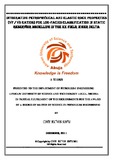| dc.contributor.author | Che, Elvis Shu | |
| dc.date.accessioned | 2016-09-08T10:14:24Z | |
| dc.date.available | 2016-09-08T10:14:24Z | |
| dc.date.issued | 2011-12-12 | |
| dc.identifier.uri | http://repository.aust.edu.ng/xmlui/handle/123456789/483 | |
| dc.identifier.uri | http://library.aust.edu.ng:8080/xmlui/handle/123456789/483 | |
| dc.description.abstract | As reservoirs become more complex and drilling operations more expensive, the need to reduce both inefficiencies and costs for constructing and analyzing high quality static models is essential. The effective and efficient production of petroleum from a reservoir lies on the proper characterization of the reservoir. Once the static model resulting from reservoir characterization is satisfactory and heterogeneities taken care of, it is but evident that the uncertainties will be minimized, hence proper optimization of production.
The problem to be solved is that of appropriately classifying log-facies for static reservoir modelling using an integrated approach (combining both petrophysical and elastic rock properties) which arises from the need to better characterise a reservoir as a function of its log-facies.
The aim of this work is to integrate petrophysical properties (porosity, water saturation and density) derived from formation evaluation analysis and elastic properties (velocities-Vp, Vs and Vp/Vs ratio) computed through a rock physics model for log-facies classification in static reservoir modelling. Hence, optimizing facies classification for seismic reservoir characterization. The methodology used for this work consists of five steps: acquisition and log data gathering; loading, importing and quality check of data; petrophysical property computations and interpretation; rock physics model computations and log-facies classification. This approach is applied to real log data from two wells in the KK field operated by the Shell Petroleum Development Corporation in the Niger Delta.
The results demonstrated an improvement in the classification obtained by integrating both petrophysical and elastic data. Good log-facies analysis leads to the construction of a better static model and without this, including characterisation input, geological models will not be very accurate. | en_US |
| dc.language.iso | en | en_US |
| dc.subject | Che Elvis Shu | en_US |
| dc.subject | Prof. Mosto Onuoha | en_US |
| dc.subject | 2011 Petroleum Engineering Theses | en_US |
| dc.subject | Well 1 (TMB_4) | en_US |
| dc.subject | Well 2 (TMB_1) | en_US |
| dc.subject | Petrophysical properties | en_US |
| dc.subject | Rock Physics | en_US |
| dc.subject | Log-Facies Classification | en_US |
| dc.subject | Petroleum Reservoirs | en_US |
| dc.subject | Conventional | en_US |
| dc.subject | Better classification | en_US |
| dc.subject | Optimization | en_US |
| dc.title | Integrating Petrophysical and Elastic Rock Properties Log- (VP / Vs Ratios) for Log-Facies Classification in Static Reservoir Modelling in the Kk Field, Niger Delta | en_US |
| dc.type | Thesis | en_US |

